Satas D., Tracton A.A. (ed.). Coatings Technology Handbook
Подождите немного. Документ загружается.

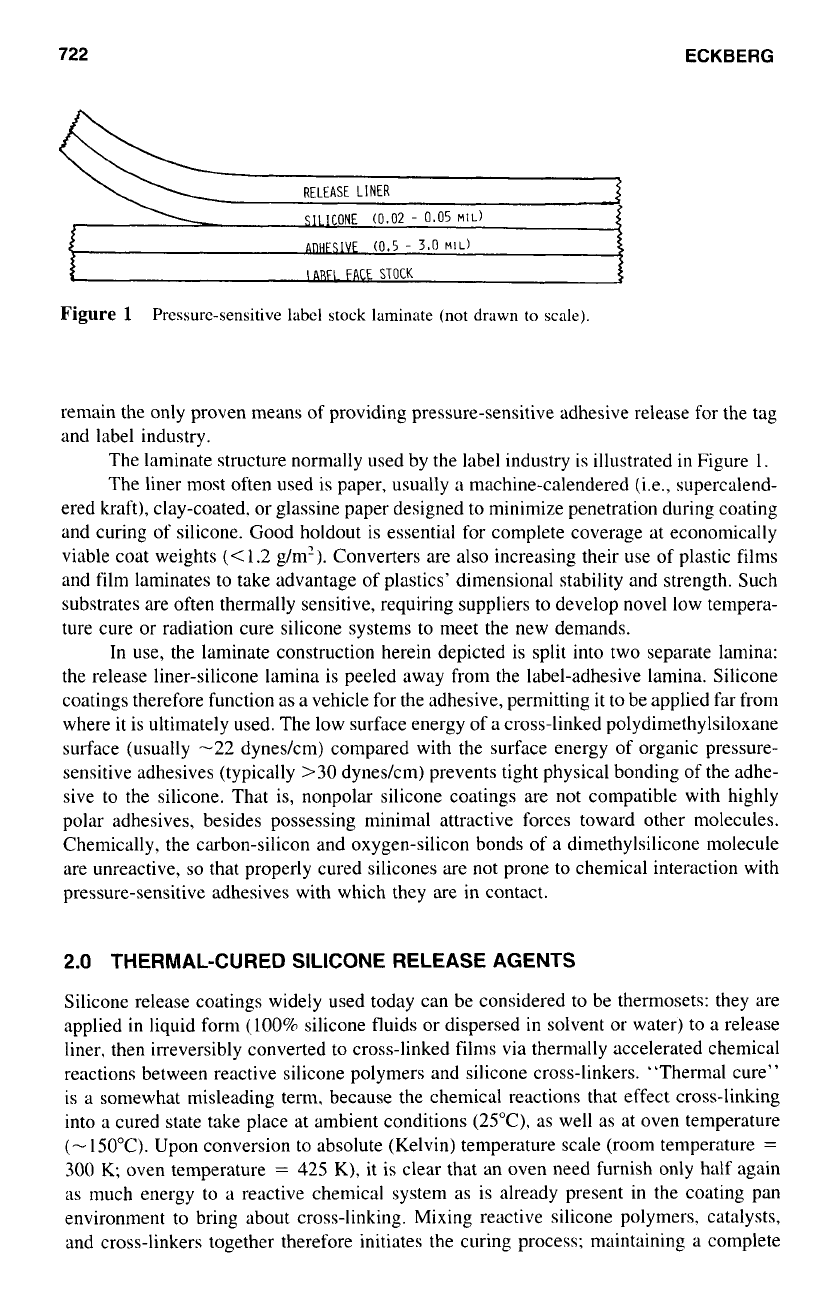
722
ECKBERG
RELEASE
LINER
Figure
1
Prcssurc-sensitive
labcl
stock laminate
(not
drawn
to
scale).
remain the only proven means
of
providing pressure-sensitive adhesive release for the tag
and label industry.
The laminate structure normally used by the label industry is illustrated
in
Figure
1.
The liner most often used is paper, usually
a
machine-calendered (i.e., supercalend-
ered kraft), clay-coated. or glassine paper designed to minimize penetration during coating
and curing of silicone. Good holdout is essential for complete coverage at economically
viable coat weights
(<
1.2
g/m’). Converters are also increasing their use of plastic films
and film laminates to take advantage of plastics’ dimensional stability and strength. Such
substrates are often thermally sensitive, requiring suppliers to develop novel low tempera-
ture cure or radiation cure silicone systems to meet the new demands.
In use, the laminate construction herein depicted is split into two separate lamina:
the release liner-silicone lamina is peeled away from the label-adhesive lamina. Silicone
coatings therefore function as a vehicle for the adhesive, permitting
it
to
be applied far from
where it is ultimately used. The low surface energy of a cross-linked polydimethylsiloxane
surface (usually -22 dyneskm) compared with the surface energy of organic pressure-
sensitive adhesives (typically
>30
dyneshn) prevents tight physical bonding of the adhe-
sive to the silicone. That is, nonpolar silicone coatings are not compatible with highly
polar adhesives, besides possessing minimal attractive forces toward other molecules.
Chemically. the carbon-silicon and oxygen-silicon bonds of a dimethylsilicone molecule
are unreactive,
so
that properly cured silicones are not prone to chemical interaction with
pressure-sensitive adhesives with which they are in contact.
2.0
THERMAL-CURED SILICONE RELEASE AGENTS
Silicone release coatings widely used today can be considered to be thermosets: they are
applied
in
liquid form
(100%
silicone fluids or dispersed in solvent or water) to a release
liner, then irreversibly converted to cross-linked tilms via thermally accelerated chemical
reactions between reactive silicone polymers and silicone cross-linkers. “Thermal cure”
is a somewhat misleading term, because the chemical reactions that effect cross-linking
into a cured state take place at ambient conditions (25°C). as well as at oven temperature
(-
150°C). Upon conversion to absolute (Kelvin) temperature scale (room temperature
=
300
K; oven temperature
=
425 K), it is clear that an oven need furnish only half again
as
much energy to
a
reactive chemical system as is already present in the coating pan
environment to bring about cross-linking. Mixing reactive silicone polymers, catalysts,
and cross-linkers together therefore initiates the curing process; maintaining a complete
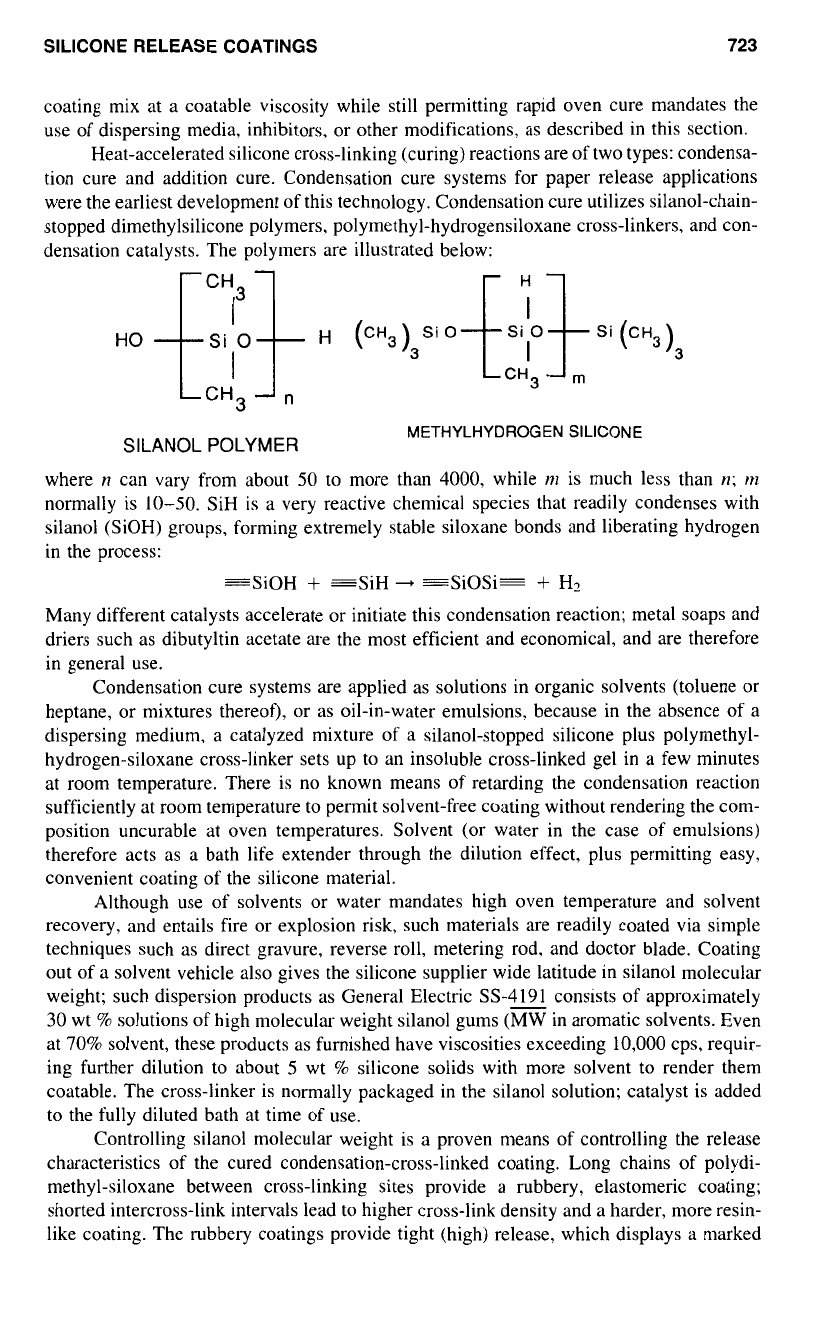
SILICONE RELEASE COATINGS
723
coating mix at
a
coatable viscosity while still permitting rapid oven cure mandates the
use of dispersing media, inhibitors, or other modifications,
as
described in this section.
Heat-accelerated silicone cross-linking (curing) reactions are
of
two types: condensa-
tion cure and addition cure. Condensation cure systems for paper release applications
were the earliest development of this technology. Condensation cure utilizes silanol-chain-
stopped dimethylsilicone polymers,
polymethyl-hydrogensiloxane
cross-linkers, and con-
densation catalysts. The polymers are illustrated below:
SILANOL
POLYMER
METHYLHYDROGEN
SILICONE
where
n
can vary from about
50
to more than
4000,
while
m
is much less than
n;
I72
normally is
10-50.
SiH is
a
very reactive chemical species that readily condenses with
silanol (SiOH) groups, forming extremely stable siloxane bonds and liberating hydrogen
in the process:
=SiOH
+
=SiH
+
=SiOSi=
+
H?
Many different catalysts accelerate or initiate this condensation reaction; metal soaps and
driers such
as
dibutyltin acetate are the most efficient and economical, and are therefore
in general use.
Condensation cure systems are applied
as
solutions in organic solvents (toluene or
heptane, or mixtures thereof), or
as
oil-in-water emulsions. because in the absence
of
a
dispersing medium,
a
catalyzed mixture of
a
silanol-stopped silicone plus polymethyl-
hydrogen-siloxane cross-linker sets up to an insoluble cross-linked gel in
a
few minutes
at room temperature. There is no known means of retarding the condensation reaction
sufficiently at room temperature
to
permit solvent-free coating without rendering the com-
position uncurable at oven temperatures. Solvent (or water in the case of emulsions)
therefore acts
as
a
bath life extender through the dilution effect, plus permitting easy.
convenient coating of the silicone material.
Although use
of
solvents or water mandates high oven temperature and solvent
recovery, and entails fire or explosion risk, such materials are readily coated via simple
techniques such
as
direct gravure, reverse roll, metering rod, and doctor blade. Coating
out
of
a
solvent vehicle also gives the silicone supplier wide latitude in silanol molecular
weight; such dispersion products
as
General Electric
SS-4191
-
consists of approximately
30
wt
%
solutions of high molecular weight silanol gums (MW in aromatic solvents. Even
at
70%
solvent, these products
as
furnished have viscosities exceeding
10,000
cps, requir-
ing further dilution to about
S
wt
%
silicone solids with more solvent to render them
coatable. The cross-linker is normally packaged in the silanol solution; catalyst is added
to
the fully diluted bath at time of use.
Controlling silanol molecular weight is
a
proven means of controlling the release
characteristics
of
the cured condensation-cross-linked coating. Long chains
of
polydi-
methyl-siloxane between cross-linking sites provide
a
rubbery, elastomeric coating;
shorted intercross-link intervals lead to higher cross-link density and
a
harder, more resin-
like coating. The rubbery coatings provide tight (high) release, which displays
a
marked
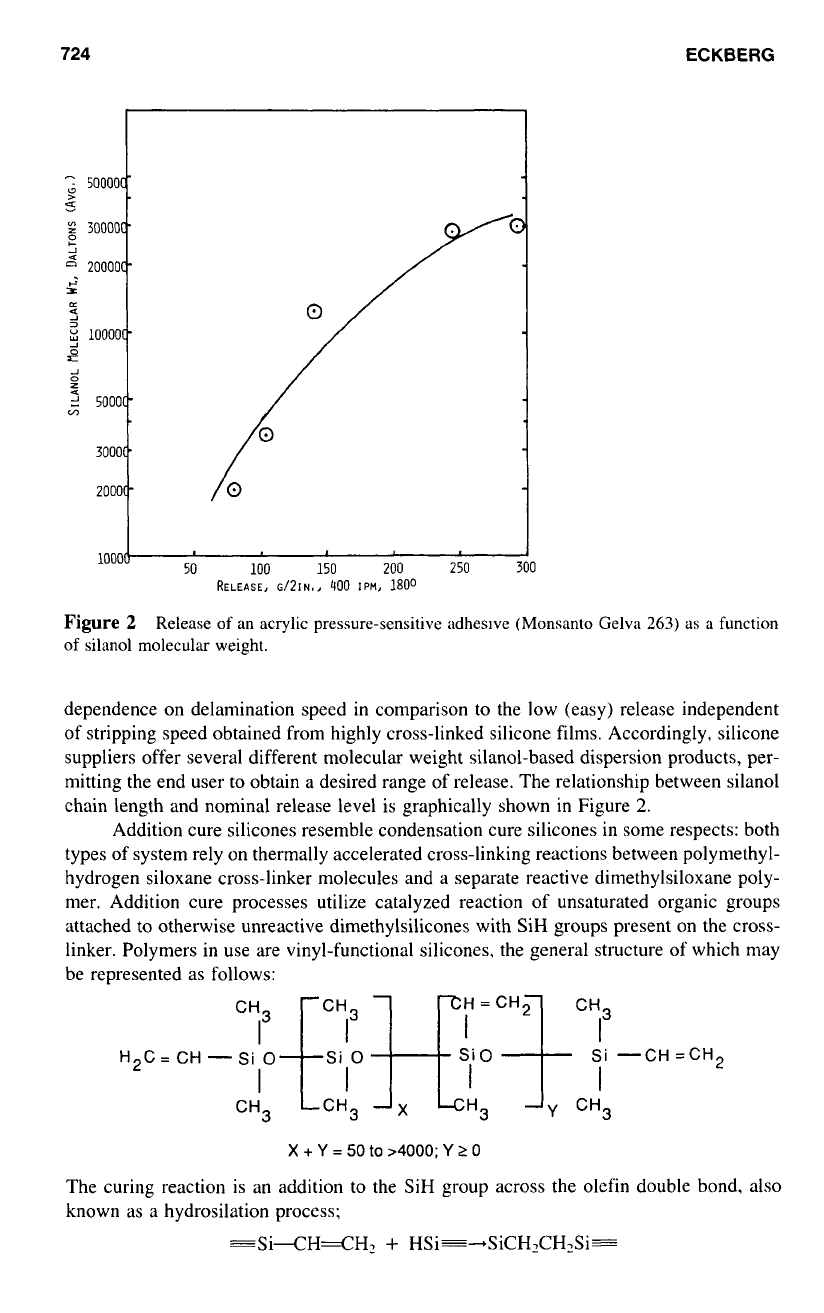
724
ECKBERG
RELEASE,
G/21Nar
400
]PM,
180’
Figure
2
Release
of
an acrylic pressure-sensitive adhesive (Monsanto Gelva
263)
as
a
function
of
silanol molecular weight.
dependence on delamination speed in comparison
to
the low (easy) release independent
of stripping speed obtained from highly cross-linked silicone films. Accordingly, silicone
suppliers offer several different molecular weight silanol-based dispersion products, per-
mitting the end user
to
obtain a desired range of release. The relationship between silanol
chain length and nominal release level is graphically shown
in
Figure
2.
Addition cure silicones resemble condensation cure silicones in some respects: both
types of system rely on thermally accelerated cross-linking reactions between polymethyl-
hydrogen siloxane cross-linker molecules and
a
separate reactive dimethylsiloxane poly-
mer. Addition cure processes utilize catalyzed reaction
of
unsaturated organic groups
attached to otherwise unreactive dimethylsilicones with SiH groups present on the cross-
linker. Polymers in use are vinyl-functional silicones. the general structure of which may
be represented as follows:
““‘{“l’
I
1,
[$CH]
“H?
H2C= CH
-si
0
I
Si
0
Si
-CH =CH2
I
CH3 CH3 H3 Y CH3
X+Y=50to>4000;Y;IO
The curing reaction is an addition
to
the SiH group across the olefin double bond, also
known as a hydrosilation process;
=Si-CH=CH2
+
HSi=--.SiCH?CH,Si=
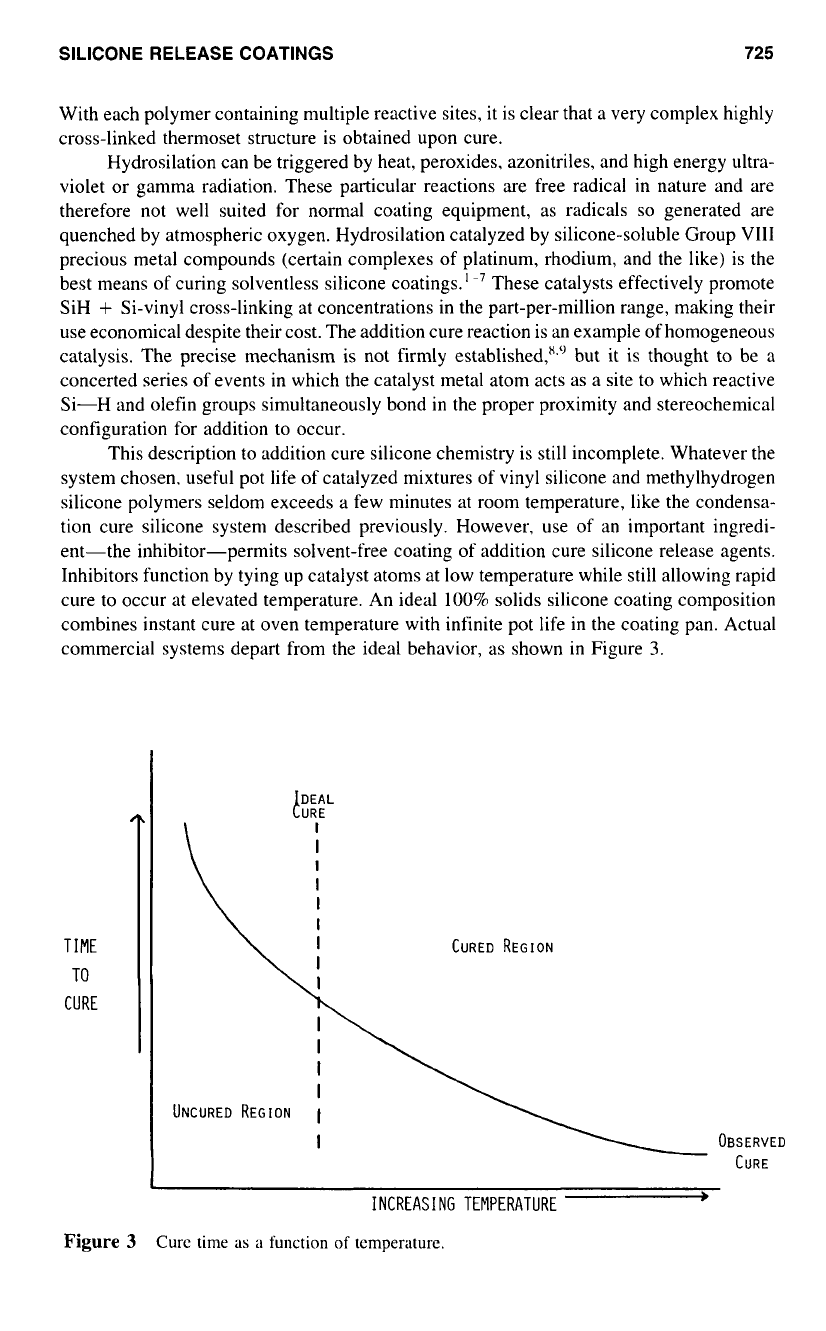
SILICONE RELEASE COATINGS
725
With each polymer containing multiple reactive sites, it is clear that a very complex highly
cross-linked thermoset structure is obtained upon cure.
Hydrosilation can be triggered by heat, peroxides, azonitriles, and high energy ultra-
violet or gamma radiation. These particular reactions are free radical in nature and are
therefore not well suited for normal coating equipment,
as
radicals
so
generated are
quenched by atmospheric oxygen. Hydrosilation catalyzed by silicone-soluble Group
VI11
precious metal compounds (certain complexes
of
platinum, rhodium, and the like) is the
best means of curing solventless silicone coatings.
’
”
These catalysts effectively promote
SiH
+
Si-vinyl cross-linking at concentrations in the part-per-million range, making their
use economical despite their cost. The addition cure reaction is an example of homogeneous
catalysis. The precise mechanism is not firmly established,x.‘’ but it is thought
to
be a
concerted series
of
events in which the catalyst metal atom acts
as
a
site
to
which reactive
Si-H and olefin groups simultaneously bond
in
the proper proximity and stereochemical
configuration for addition to occur.
This description to addition cure silicone chemistry is still incomplete. Whatever the
system chosen, useful pot life
of
catalyzed mixtures
of
vinyl silicone and methylhydrogen
silicone polymers seldom exceeds a few minutes at room temperature, like the condensa-
tion cure silicone system described previously. However, use
of
an important ingredi-
ent-the inhibitor-permits solvent-free coating of addition cure silicone release agents.
Inhibitors function by tying up catalyst atoms at low temperature while still allowing rapid
cure to occur at elevated temperature. An ideal
100%
solids silicone coating composition
combines instant cure at oven temperature with infinite pot life in the coating pan. Actual
commercial systems depart from the ideal behavior, as shown
in
Figure
3.
TIME
TO
CURE
Figure
3
CURED REGION
1-
OBSERVED
CURE
Cure
time
us
a
function of temperature.
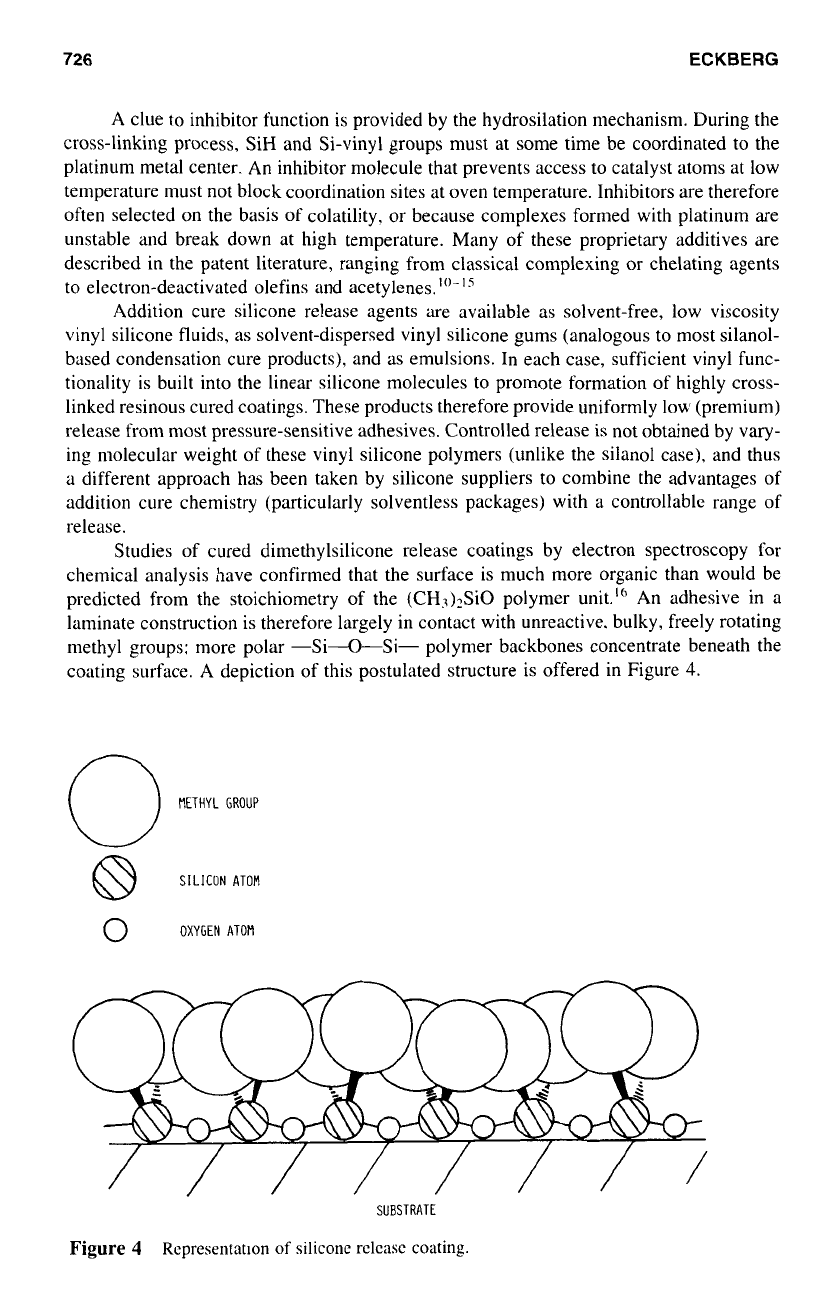
726
ECKBERG
A
clue to inhibitor function is provided by the hydrosilation mechanism. During the
cross-linking process, SiH and Si-vinyl groups must at some time be coordinated to the
platinum metal center. An inhibitor molecule that prevents access to catalyst atoms at low
temperature must not block coordination sites at oven temperature. Inhibitors are therefore
often selected on the basis of colatility. or because complexes formed with platinum are
unstable and break down at high temperature. Many of these proprietary additives are
described in the patent literature, ranging from classical complexing or chelating agents
to electron-deactivated olefins and
Addition cure silicone release agents are available as solvent-free, low viscosity
vinyl silicone fluids, as solvent-dispersed vinyl silicone gums (analogous to most silanol-
based condensation cure products), and as emulsions. In each case, sufficient vinyl func-
tionality is built into the linear silicone molecules to promote formation of highly cross-
linked resinous cured coatings. These products therefore provide uniformly low (premium)
release from most pressure-sensitive adhesives. Controlled release is not obtained by vary-
ing molecular weight of these vinyl silicone polymers (unlike the silanol case), and thus
a
different approach has been taken by silicone suppliers to combine the advantages of
addition cure chemistry (particularly solventless packages) with a controllable range of
release.
Studies of cured dimethylsilicone release coatings by electron spectroscopy for
chemical analysis have confirmed that the surface is much more organic than would be
predicted from the stoichiometry of the (CH3)?Si0 polymer unit.'" An adhesive in a
laminate construction is therefore largely in contact with unreactive. bulky, freely rotating
methyl groups: more polar -Si+-Si- polymer backbones concentrate beneath the
coating surface.
A
depiction of this postulated structure is offered in Figure
4.
c3
SILICON
ATOM
0
OXYGEN ATOM
SUBSTRATE
Figure
4
Rcpresentntlon
of
siliconc
rclcnsc
coating.
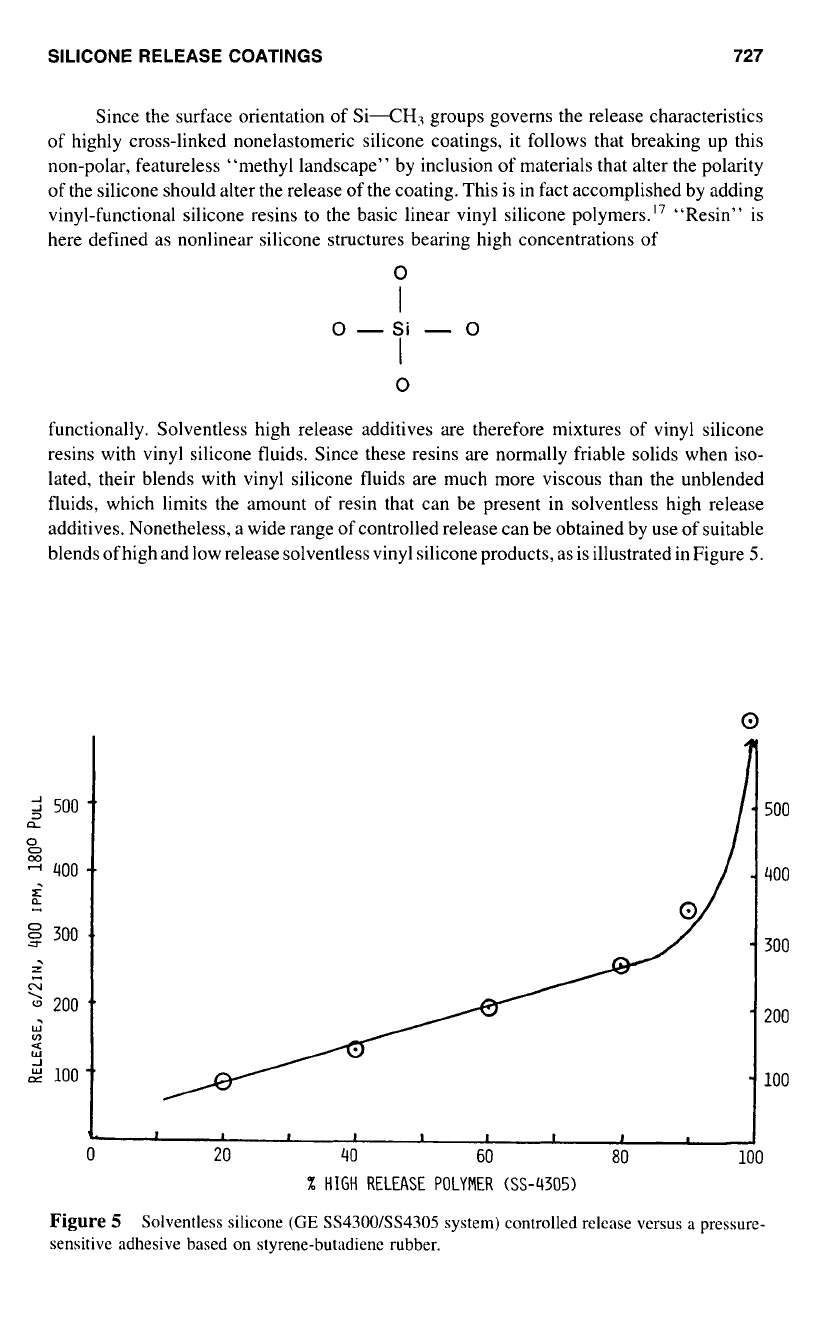
SILICONE RELEASE COATINGS
727
Since the surface orientation of Si-CH3 groups governs the release characteristics
of highly cross-linked nonelastomeric silicone coatings, it follows that breaking up this
non-polar, featureless “methyl landscape” by inclusion
of
materials that alter the polarity
of the silicone should alter the release
of
the coating. This is in fact accomplished by adding
vinyl-functional silicone resins to the basic linear vinyl silicone polymers.” “Resin” is
here defined as nonlinear silicone structures bearing high concentrations
of
0
I
I
0-Si
-0
0
functionally. Solventless high release additives are therefore mixtures
of
vinyl silicone
resins with vinyl silicone fluids. Since these resins are normally friable solids when iso-
lated, their blends with vinyl silicone fluids are much more viscous than the unblended
fluids, which limits the amount of resin that can be present in solventless high release
additives. Nonetheless, a wide range of controlled release can be obtained by use of suitable
blends of high and low release solventless vinyl silicone products, as is illustrated in Figure
5.
2
500
00
a
2
400
I
g
300
m
\
200
W
v)
W
-1
a
2
100
500
400
300
200
100
%
HIGH
RELEASE POLYMER (SS-4305)
Figure
5
Solventless silicone
(GE
SS4300/SS4305
system) controlled release versus
a
pressure-
sensitive adhesive based on styrene-butadiene rubber.
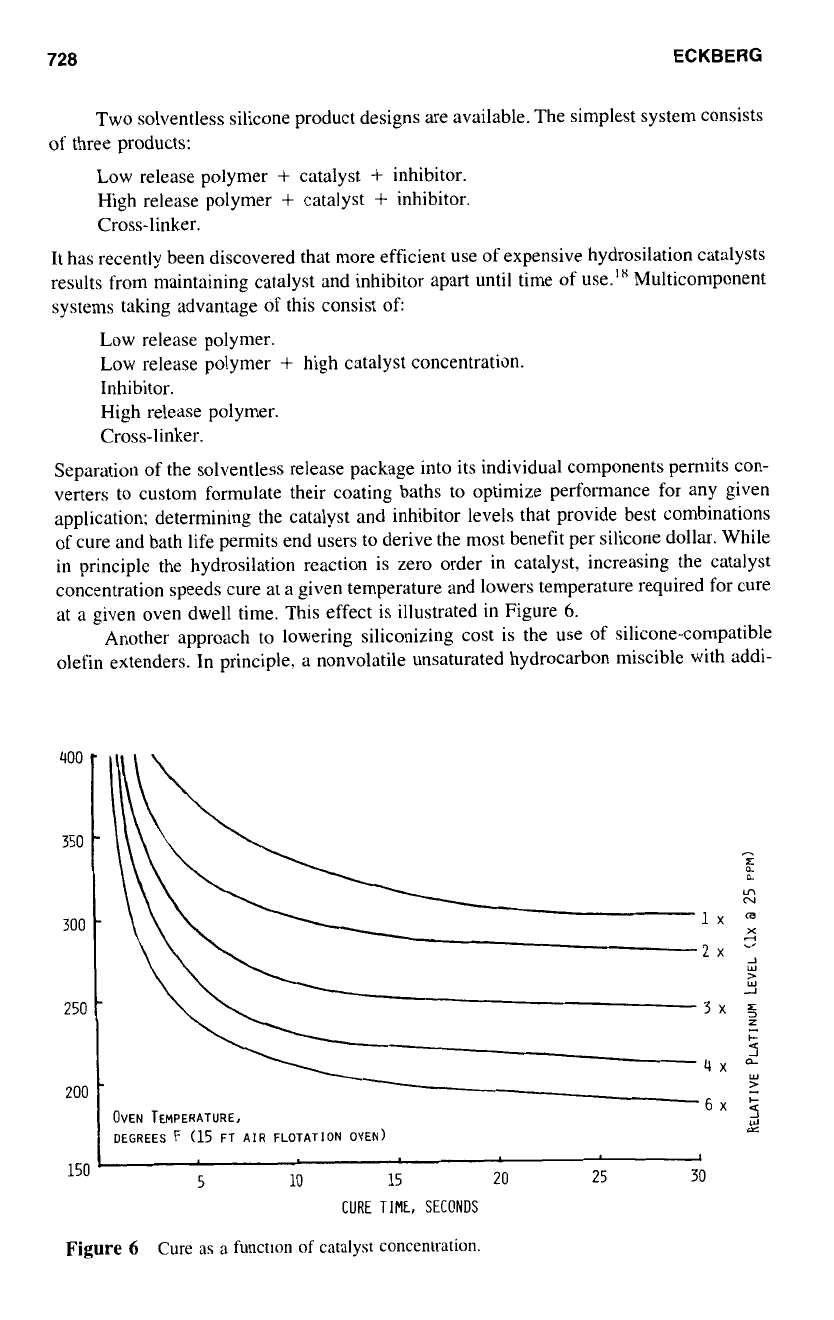
728
ECKBERG
Two
solventless silicone product designs are available. The simplest system consists
of
three products:
Low release polymer
+
catalyst
+
inhibitor.
High release polymer
+
catalyst
+
inhibitor.
Cross-linker.
It has recently been discovered that more efficient use of expensive hydrosilation catalysts
results from maintaining catalyst and inhibitor apart until time
of
use." Multicomponent
systems taking advantage
of
this consist
of
Low release polymer.
Low release polymer
+
high catalyst concentration.
Inhibitor.
High release polymer.
Cross-linker.
Separation of the solventless release package into its individual components permits con-
verters
to
custom formulate their coating baths to optimize performance for any given
application; determining the catalyst and inhibitor levels that provide best combinations
of cure and bath life permits end users
to
derive the most benefit per silicone dollar. While
in
principle the hydrosilation reaction is zero order in catalyst, increasing the catalyst
concentration speeds cure at a given temperature and lowers temperature required for cure
at a given oven dwell time. This effect is illustrated in Figure
6.
Another approach to lowering siliconizing cost is the use of silicone-compatible
olefin extenders. In principle. a nonvolatile unsaturated hydrocarbon miscible with addi-
400
-
350
300
-
250
-
OVEN
TEMPERATURE,
DEGREES
F
(15
FT
AIR
FLOTATION
OVEN)
2oo
150
5
10
15
20
25
30
CURE
TIME,
SECFNDS
Figure
6
Cure
as a functlon
of
catalyst concentration
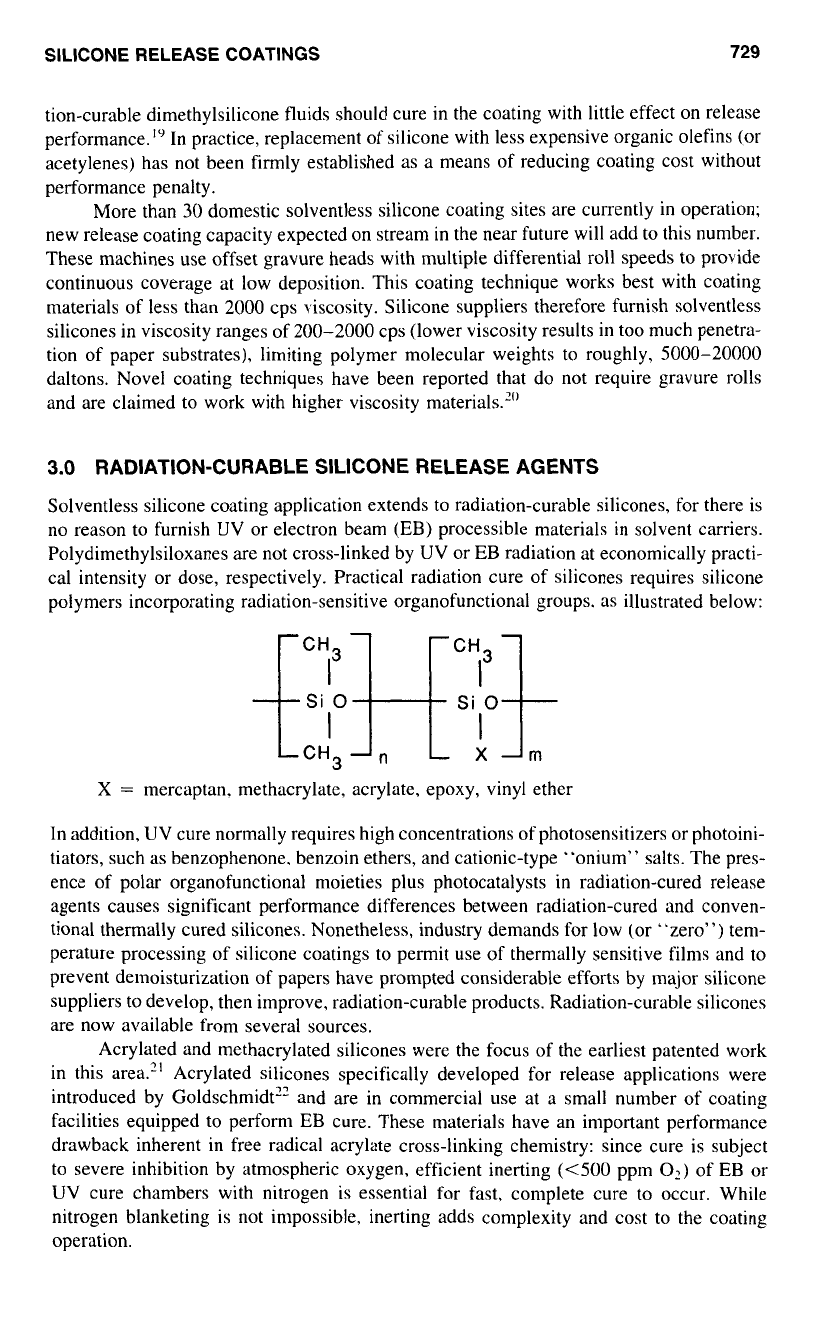
SILICONE RELEASE COATINGS
729
tion-curable dimethylsilicone fluids should cure in the coating with little effect on release
performance.’” In practice, replacement of silicone with less expensive organic olefins
(or
acetylenes) has not been firmly established as a means of reducing coating cost without
performance penalty.
More than
30
domestic solventless silicone coating sites are currently in operation;
new release coating capacity expected on stream in the near future will add
to
this number.
These machines use offset gravure heads with multiple differential roll speeds to provide
continuous coverage at low deposition. This coating technique works best with coating
materials of less than
2000
cps viscosity. Silicone suppliers therefore furnish solventless
silicones in viscosity ranges of 200-2000 cps (lower viscosity results in too much penetra-
tion of paper substrates), limiting polymer molecular weights to roughly, 5000-20000
daltons. Novel coating techniques have been reported that do not require gravure rolls
and are claimed to work with higher viscosity materials.?”
3.0
RADIATION-CURABLE SILICONE RELEASE AGENTS
Solventless silicone coating application extends to radiation-curable silicones, for there is
no reason to furnish UV or electron beam (EB) processible materials in solvent carriers.
Polydimethylsiloxanes are not cross-linked by UV or EB radiation at economically practi-
cal intensity or dose, respectively. Practical radiation cure of silicones requires silicone
polymers incorporating radiation-sensitive organofunctional groups.
as
illustrated below:
X
=
mercaptan. methacrylate, acrylate, epoxy, vinyl ether
In addition, UV cure normally requires high concentrations of photosensitizers or photoini-
tiators, such as benzophenone. benzoin ethers, and cationic-type “onium” salts. The pres-
ence of polar organofunctional moieties plus photocatalysts in radiation-cured release
agents causes significant performance differences between radiation-cured and conven-
tional thermally cured silicones. Nonetheless, industry demands for low (or “zero”) tem-
perature processing of silicone coatings
to
permit use of thermally sensitive films and to
prevent demoisturization of papers have prompted considerable efforts by major silicone
suppliers to develop, then improve, radiation-curable products. Radiation-curable silicones
are now available from several sources.
Acrylated and methacrylated silicones were the focus of the earliest patented work
in this area.?” Acrylated silicones specifically developed for release applications were
introduced by Goldschmidt” and are in commercial use at a small number
of
coating
facilities equipped to perform EB cure. These materials have an important performance
drawback inherent in free radical acrylate cross-linking chemistry: since cure is subject
to severe inhibition by atmospheric oxygen, efficient inerting
(<500
ppm
02)
of
EB
or
UV
cure chambers with nitrogen is essential for fast, complete cure
to
occur. While
nitrogen blanketing is not impossible, inerting adds complexity and cost to the coating
operation.
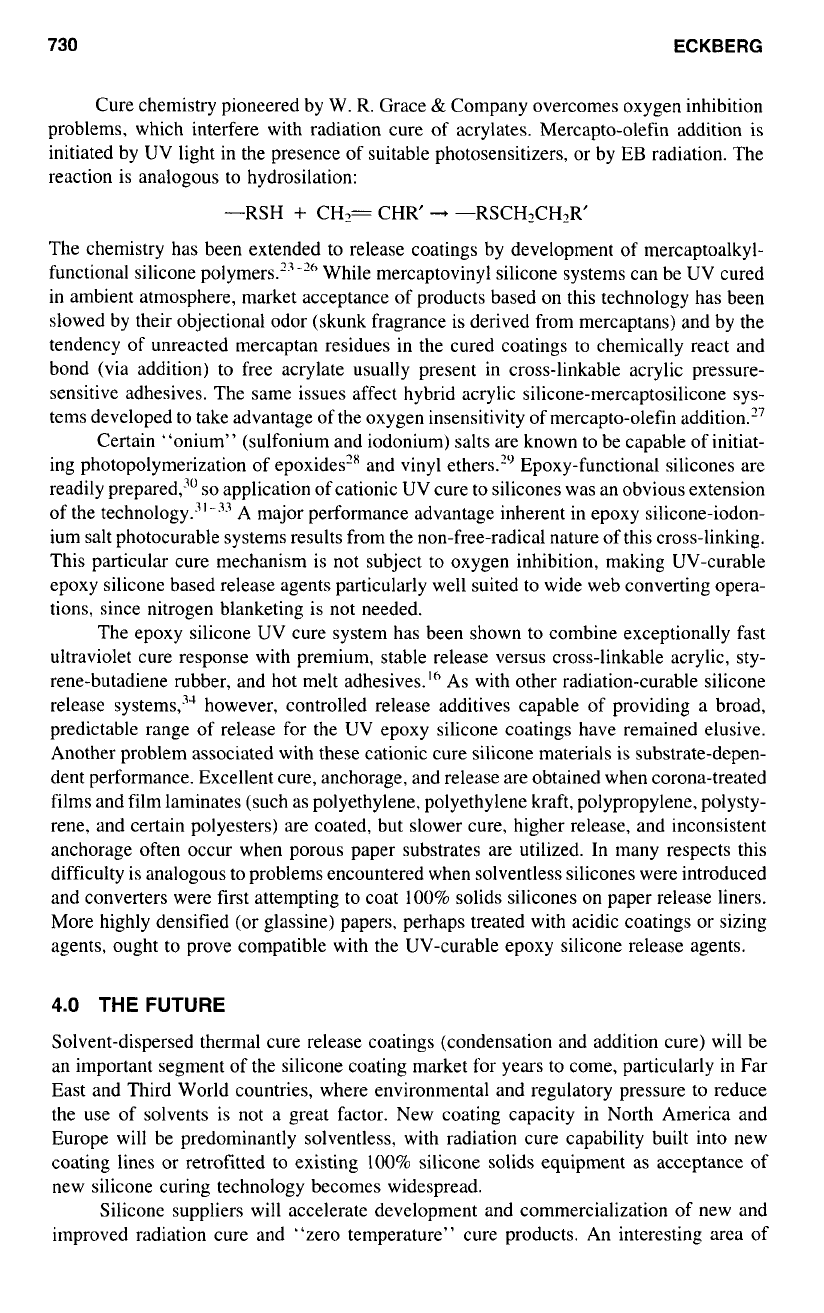
730
ECKBERG
Cure chemistry pioneered by W. R. Grace
&
Company overcomes oxygen inhibition
problems, which interfere with radiation cure of acrylates. Mercapto-olefin addition is
initiated by UV light in the presence of suitable photosensitizers, or by EB radiation. The
reaction is analogous to hydrosilation:
“RSH
+
CH?= CHR’
-+
-RSCH,CH?R’
The chemistry has been extended to release coatings by development
of
mercaptoalkyl-
functional silicone While mercaptovinyl silicone systems can be UV cured
in ambient atmosphere, market acceptance of products based on this technology has been
slowed by their objectional odor (skunk fragrance is derived from mercaptans) and by the
tendency of unreacted mercaptan residues in the cured coatings to chemically react and
bond (via addition) to free acrylate usually present in cross-linkable acrylic pressure-
sensitive adhesives. The same issues affect hybrid acrylic
silicone-mercaptosilicone
sys-
tems developed to take advantage of the oxygen insensitivity of mercapto-olefin addition.”
Certain “onium” (sulfonium and iodonium) salts are known to be capable of initiat-
ing photopolymerization of epoxides” and vinyl ethers.‘” Epoxy-functional silicones are
readily prepared,3”
so
application of cationic UV cure
to
silicones was an obvious extension
of the A major performance advantage inherent in epoxy silicone-iodon-
ium salt photocurable systems results from the non-free-radical nature of this cross-linking.
This particular cure mechanism is not subject to oxygen inhibition, making UV-curable
epoxy silicone based release agents particularly well suited to wide web converting opera-
tions, since nitrogen blanketing is not needed.
The epoxy silicone UV cure system has been shown to combine exceptionally fast
ultraviolet cure response with premium, stable release versus cross-linkable acrylic, sty-
rene-butadiene rubber, and hot melt adhesives.I6 As with other radiation-curable silicone
release systems,” however, controlled release additives capable of providing
a
broad,
predictable range of release for the UV epoxy silicone coatings have remained elusive.
Another problem associated with these cationic cure silicone materials is substrate-depen-
dent performance. Excellent cure, anchorage, and release are obtained when corona-treated
films and film laminates (such
as
polyethylene, polyethylene kraft, polypropylene, polysty-
rene, and certain polyesters) are coated, but slower cure, higher release, and inconsistent
anchorage often occur when porous paper substrates are utilized. In many respects this
difficulty is analogous to problems encountered when solventless silicones were introduced
and converters were first attempting to coat
100%
solids silicones on paper release liners.
More highly densified (or glassine) papers, perhaps treated with acidic coatings or sizing
agents, ought to prove compatible with the UV-curable epoxy silicone release agents.
4.0
THE
FUTURE
Solvent-dispersed thermal cure release coatings (condensation and addition cure) will be
an important segment of the silicone coating market for years to come, particularly in Far
East and Third World countries, where environmental and regulatory pressure to reduce
the use of solvents is not
a
great factor. New coating capacity in North America and
Europe will be predominantly solventless, with radiation cure capability built into new
coating lines or retrofitted to existing
100%
silicone solids equipment
as
acceptance of
new silicone curing technology becomes widespread.
Silicone suppliers will accelerate development and commercialization
of
new and
improved radiation cure and “zero temperature” cure products. An interesting area
of
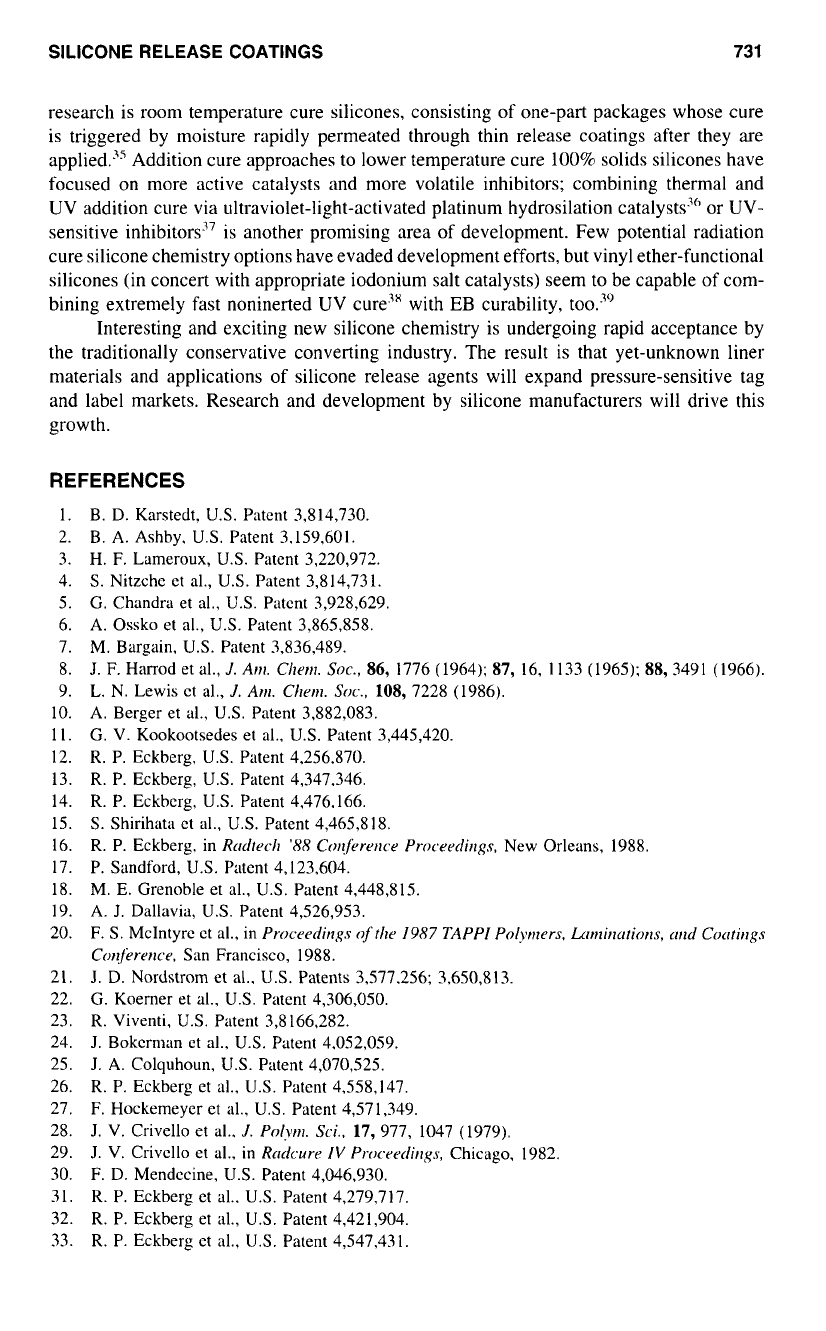
SILICONE RELEASE COATINGS
731
research is room temperature cure silicones, consisting of one-part packages whose cure
is triggered by moisture rapidly permeated through thin release coatings after they are
applied.3s Addition cure approaches to lower temperature cure
100%
solids silicones have
focused
on
more active catalysts and more volatile inhibitors; combining thermal and
UV addition cure via ultraviolet-light-activated platinum hydrosilation catalysts3" or UV-
sensitive
inhibitor^'^
is another promising area
of
development. Few potential radiation
cure silicone chemistry options have evaded development efforts, but vinyl ether-functional
silicones (in concert with appropriate iodonium salt catalysts) seem to be capable
of
com-
bining extremely fast noninerted UV cure3x with
EB
curability, too.'"
Interesting and exciting new silicone chemistry is undergoing rapid acceptance by
the traditionally conservative converting industry. The result is that yet-unknown liner
materials and applications
of
silicone release agents will expand pressure-sensitive tag
and label markets. Research and development by silicone manufacturers will drive this
growth.
REFERENCES
1.
2.
3.
4.
S.
6.
7.
8.
9.
10.
1
I.
12.
13.
14.
15.
16.
17.
18.
19.
20.
21.
22.
23.
24.
25.
26.
27.
28.
29.
30.
31.
32.
33.
B.
D.
Karstedt,
U.S.
Patent
3,814,730.
B.
A.
Ashby.
U.S.
Patent
3,159,601.
H. F. Lameroux,
U.S.
Patent
3,220,972.
S.
Nitzche et al.,
U.S.
Patent
3,814,731.
G. Chandra et al.,
U.S.
Patent
3,928,629.
A.
Ossko et al.,
U.S.
Patent
3,865,858.
M. Bargain,
U.S.
Patent
3,836,489.
J.
F.
Harrod et
al.,
J.
Am
Clrrrrr.
Soc.,
86,
1776 (1964);
87,
16, 1133 (1965);
88,
3491 (1966).
L.
N. Lewis et al.,
J.
AM.
Cherrr.
Soc.,
108,
7228 (1986).
A.
Berger et
al.,
U.S.
Patent
3,882,083.
G. V. Kookootsedes et al.,
U.S.
Patent
3,445,420.
R.
P. Eckberg,
U.S.
Patent
4,256.870.
R.
P. Eckberg,
U.S.
Patent
4,347.346.
R.
P. Eckberg.
U.S.
Patent
4,476.166.
S.
Shirihatn et
al.,
U.S.
Patent
4,465,818.
R.
P. Eckberg. in
Rrrdtrch
'88
Corzjirrrr1c.e
Proceedirlgs,
New Orleans,
1988.
P. Sandford,
U.S.
Patent
4,123,604.
M.
E. Grenoble et al.,
U.S.
Patent
4,448,815.
A.
J.
Dallavia,
U.S.
Patent
4,526,953.
F.
S.
McIntyrc et al., in
Proceedings
ofthe
1987 TAPPI
Polyrzers.
Lcrrrlirrcrtiotls,
crrrd
Cotrrirrgs
Corzfererm,
San Francisco,
1988.
J.
D.
Nordstrom et al..
U.S.
Patents
3,577.256; 3,650,813.
G. Koerner
et
al.,
U.S.
Patent
4,306,050.
R.
Viventi,
U.S.
Patent
3,8166,282.
J.
Bokcrnmm et al..
U.S.
Patent
4.052,059.
J.
A.
Colquhoun,
U.S.
Patent
4,070,525.
R.
P. Eckberg et
al.,
U.S.
Patent
4,558,147.
F.
Hockemeyer
et
al..
U.S.
Patent
4,571,349.
J.
V. Crivello et al..
J.
Po/yr?r.
Sci..
17,
977, 1047 (1979).
J.
V.
Crivello et al., in
Rrrrlcure
/V
Procerdirlgs,
Chicago.
1982.
F.
D.
Mendccine,
U.S.
Patent
4,046,930.
R.
P. Eckberg
et
al..
U.S.
Patent
4,279,717.
R.
P. Eckberg et
al.,
U.S.
Patent
4,421,904.
R.
P. Eckberg et al.,
U.S.
Patent
4,547,431.
